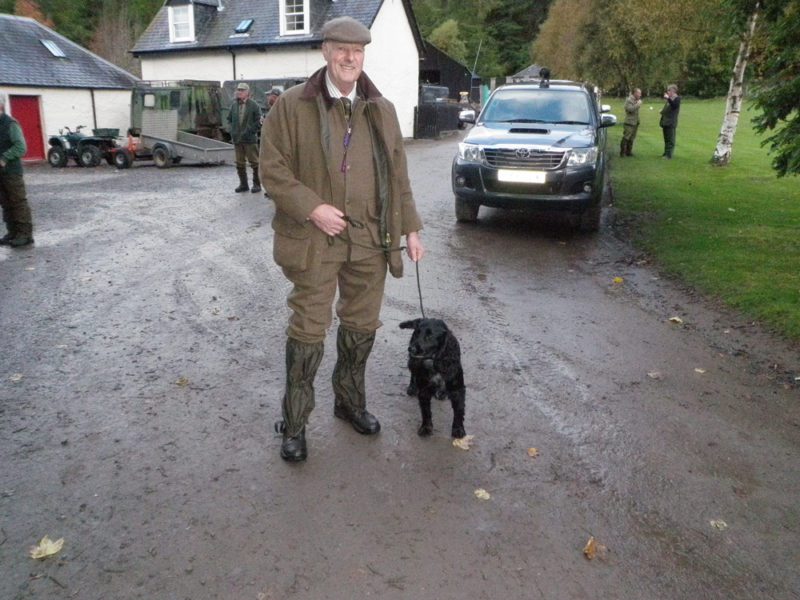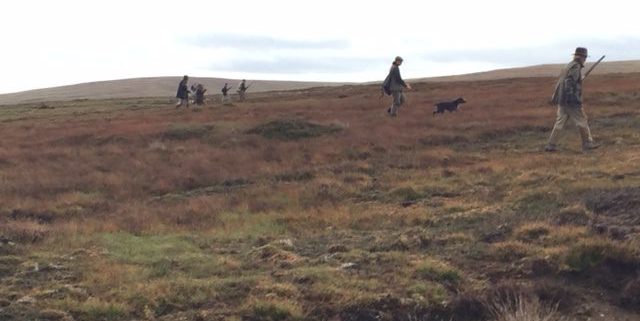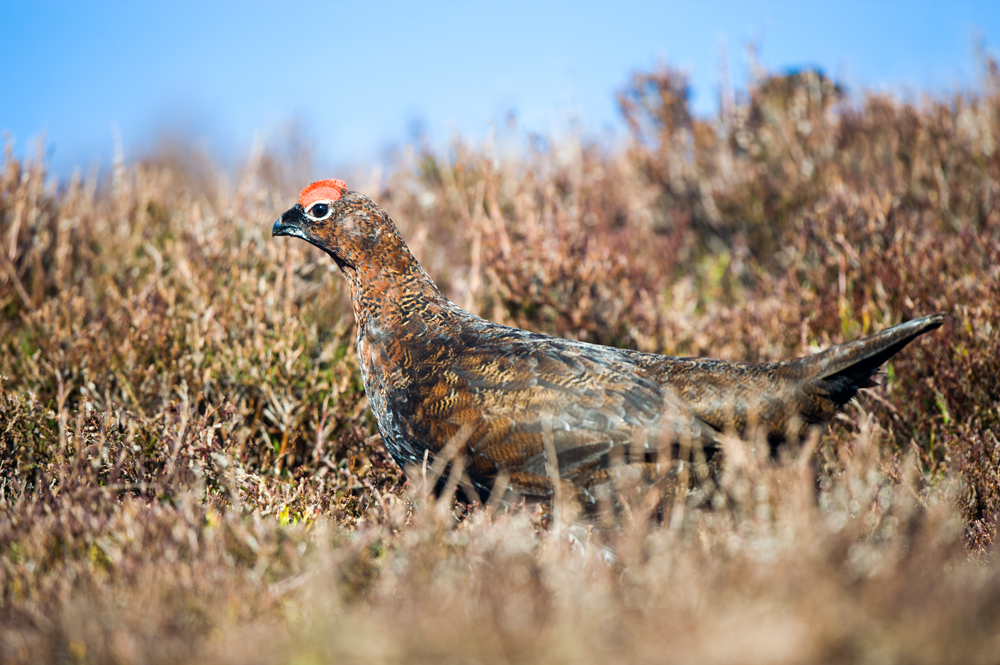Click here to read part one of this Scottish hunting adventure.
Xenophon’s troops hunted partridge on their march. Our Anabasis was on the third of our hunting days in Scotland—walk-up red grouse.
On driven days the gamekeepers, dog handlers, loaders, and drivers were organized by Vernon Waters, our outfitter, and Roddy Frazer, the estate’s head gamekeeper, like a brigade on the march. Today was a driven day, but our group was downsized to squad size—five gamekeepers and their dogs led by Roddy and Vernon with Jim, David, Aidan, Amos, and me hunting the moors; Anne, Barb, and Gail would walk the dirt track and watch. Tripp and Bill, with their stronger legs, were off walking the very high moors with a gamekeeper and a dog. We’d see them at lunch.
At least they told us Tripp and Bill were hunting higher. We drove up and up to our stretch of moors, and I didn’t see higher—just one high ridge off in the distance with—holy cow!—three very small stick figures climbing up and up. They’d need their strong legs. I heard a very faint shot from that direction and hoped that Tripp had connected. He’d missed the driven grouse day, so today was his only chance at red grouse.
A quick meeting with Roddy; walk in a line 30 yards apart; the gamekeepers and their dogs close behind us; the birds flush as the shooters progress; dogs neither pointing nor flushing, only retrieving, guns open while they did; Roddy dressing the line when someone was behind or ahead. All clear? Spread out, and let’s go!

One of the loaders, Gordon, with his cocker spaniel.
It felt like I was walking on a sponge. Ankle to mid-shin grass and heather. Colors bleak and beautiful, too late in the season for the brilliant purple of the moors. This was a sedate, subdued beauty . . .
My thoughts were interrupted by a bird flushing 30 yards in front of me and quartering right. My 16 gauge came up on autopilot and fired. The bird folded 45 yards away.
“Line halt,” Roddy shouted as he sent out his strong, handsome black Lab, Coal, to find the bird.
As we waited we admired the work and muscular grace of the dog. Coal found the bird quickly, then proudly carried it back to his master. Roddy walked over and showed me the bird—a fine adult male.
I beamed. All the ruffed grouse hunters among us exchanged significant looks. That bird flushed like a ruffie, flew at the same speed as a ruffie, and the cover was open without the usual 50 or so saplings, three pine trees, and an apple tree in between us and the bird. This we could do, and do well. No incomers, just going-away and crossing shots. We were used to this. We grinned.

The author admiring a handsome red grouse.
Ten minutes later Jim put up a bird 20 yards in front of him and a bit to the right. A crossing shot. Jim “outdrew” Amos and folded the bird.
The two old friends smiled at each other. Amos shook his head. One had been outdrawing the other on bird hunts for decades now.
“The Boss strikes again,” I yelled. Jim’s son, David, and his grandson, Aidan, openly applauded. Coal easily found the stone-dead grouse and brought it back to hand—another fine adult male. Jim beamed.
Several flocks of birds flushed far ahead of us—wary, educated, late-season adult grouse—and flew over the ridge 250 yards ahead.
“We’ll get a chance at them on the other side,” said Roddy.
And on we slogged through heather and bog. Two birds flushed 30 yards in front of Amos and broke right. Two shots and a bird was pinwheeling through the air, wing-tipped. The bird started running as soon as it hit the ground and led Coal on a long chase. Five minutes later the Lab pranced proudly back over the rise with the indignant grouse held gently in his mouth.
As we watched the retrieve, we also watched more birds flush wild ahead of us.
Wait for us; we’re on our way.
As we approached the crest of the hill, I looked right and saw Jim disappear into the heather as if the moor had covered him up. Vernon, who was walking behind Jim, hurried forward a few yards to help and fell onto the ground. Both men got up smiling. I chuckled to myself, took two steps, and went down as if pole-axed.
The big boggy spots in the moor were easy to spot and avoid, but there were small ones hidden in the heather and grass that fooled you. You’d be walking on the spongy-feeling moor, take a step to what looked like “solid” ground, and your leg would suddenly go down two feet or more—hard to keep your balance then. We protected the guns as we fell, got up, dressed the line, and kept going, moving more and more suspiciously.
Suspicions and all, I fell two more times that day, bouncing well on the sponge-like moor.
We crested the ridge and watched 25 birds flush wild in front of us, gliding far ahead and a bit to the right. I took another step and two birds flushed 15 yards in front of me, angling left. I dropped the first one and missed the second, watching it fly five more yards and then fold up as Aidan “wiped my eye” with a fine shot. Father and grandfather smiled proudly. I did, too.

And so the walk begins. (Photo: Anne Morgan)
“Nice shot, Aidan.”
More work for Coal. We paused to watch the fine retrieves.
The morning went on. David made a fine shot on a bird crossing left. Aidan grinned at him.
“Good one, Dad.”
Jim, Amos, and I all scored again. We also missed several shots. Many birds flushed wild. Then time for lunch.
David, Amos and Aidan called it a hunt and went back with the ladies to shop in town—something about birthdays and Christmas and fine woolens and rare whiskeys. (I hope that they remember me.) Jim and I elected to stay, meet Tripp and Bill for lunch, and continue to hunt.

Breaking for lunch.
Tripp and Bill came in with stories and birds. First red grouse for Tripp. We tailgated, ate sandwiches and hot soup, drank water or Coke, and rested. I napped in the shotgun seat of the Land Rover.
Soon we were on the moors again. This time four shooters: Tripp, Bill, Jim, and me. The high moors had worn Tripp and Bill down a bit, so Jim and I could keep up. Two more hours of birds, shots, retrieves, falls, and ridges. Finally Jim and I quit and watched the “younger legs” depart uphill. I found a nice boulder and sat down. Jim sat in the “moor buggy” that had been following us. A gamekeeper and his dog stayed with us. We were always looked after well.
“We’ll go on another half-mile, then turn around and pass below you. You’ll join us then. Have a good rest, and watch for birds flushing from us to you.” Roddy turned and walked on.
I smiled and waved and rested, seated on my boulder with my gun. Fifteen minutes passed. The young gamekeeper said, “Four birds coming down the hill.” I turned and, from my seated position, took an incomer. We watched the gamekeeper’s springer spaniel retrieve the bird.
“Nice shot,” said Jim.
“That’s it for me today,” I said. “I’ll never make a better. That’ll be my last red grouse.”
Driven Spanish partridge in the morning.
Cover image: Karen Appleyard/iStock


